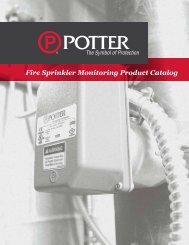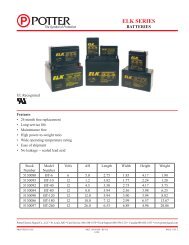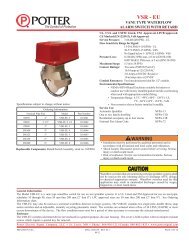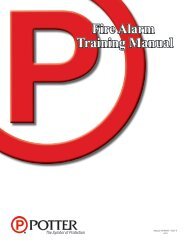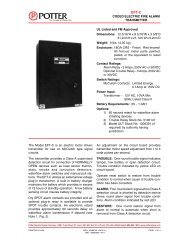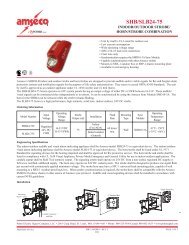Training Manual - Potter Electric Signal Company, LLC
Training Manual - Potter Electric Signal Company, LLC
Training Manual - Potter Electric Signal Company, LLC
Create successful ePaper yourself
Turn your PDF publications into a flip-book with our unique Google optimized e-Paper software.
Quarterly<br />
(continued)<br />
Semi-annually<br />
drain until air begins to escape, then close the valve securely. Also be<br />
sure the upper and lower priming valves are closed securely.<br />
Check cold weather valves (if provided) in the Fall, before freezing weather.<br />
The valves should be closed and that portion of the system drained. In the<br />
Spring, as soon as freezing weather has passed, the cold weather valve should<br />
be reopened.<br />
Note: Cold weather valves are sometimes used to isolate a portion of<br />
a sprinkler system that might be subject to freezing temperatures. During<br />
cold weather, the valve is closed and that portion of the system is drained.<br />
However, cold weather valves are not desirable, as protection is not provided<br />
during cold weather or if valve is inadvertently left closed. Also, NFPA 13<br />
does not recognize cold weather valves. A preferred arrangement would be<br />
to provide a dry pipe system in the unheated area, or an antifreeze loop in a<br />
small area.<br />
Pipe Blockage<br />
It is important that the sprinkler system piping be maintained free of obstructions,<br />
so, periodically, sprinkler systems — including valves and piping — should be<br />
examined internally. Where unfavorable conditions such as those listed below are<br />
found, the systems should be examined for blockage immediately, and at five-year<br />
intervals thereafter. Look for:<br />
A. Defective screens at pump intakes where pumps take suction from<br />
streams, ponds or lakes. Failure of the screens might allow debris into the<br />
pump suction and into the system piping.<br />
B. Debris and obstructive material discharged during routine water tests, such<br />
as from hydrant water flow tests or 2-inch main drain tests.<br />
C. Debris found in dry-pipe valves, check valves and fire pumps during<br />
maintenance.<br />
D. Heavy discoloration of water during 2-inch drain tests, or plugging of the<br />
inspector’s test connections.<br />
E. Plugged piping, which is found during system alterations or after system<br />
failure during fires.<br />
F. Failure to flush underground mains following installation or repairs.<br />
Debris might have been left in the piping during construction.<br />
G. A record of broken water mains in the area. Repair of these broken pipes<br />
could have introduced debris into the system.<br />
Tests Tests are required at various frequencies as noted below. Use the Inspection Forms at the end of this<br />
chapter to record all test results.<br />
Quarterly<br />
All Sprinkler Systems:<br />
Flow test main drains.<br />
This involves noting and recording the pressure of the gauge on the<br />
lower side of the sprinkler valve (Figure 2-2 above). (This is the static water<br />
supply pressure.) Open the 2-inch main drain fully; after the<br />
Quarterly<br />
(continued)<br />
Semi-annually<br />
Annually<br />
flow has stabilized, note and record the pressure on the gauge again.<br />
(This is the residual water supply pressure.) If the pressure readings vary<br />
significantly from those readings previously recorded, there is indication<br />
that something may be wrong with the water supply — such as a closed<br />
valve or blocked pipe. Loss of pressure of more than 10 percent should<br />
be investigated immediately to determine its cause. The effect that the<br />
drop in pressure will have on the sprinkler system operation should also be<br />
determined to assure that the system will perform satisfactorily.<br />
Wet Pipe System:<br />
Test water flow alarms.<br />
Test alarms by opening the inspector’s test connection. This simulates<br />
the flow of water from one sprinkler head and will activate the water<br />
motor alarm as well as the flow switch or pressure switch. (When freezing<br />
weather prohibits using the inspector’s test, the alarm by-pass connection can<br />
be used. However, use of the alarm by-pass does not test the operation<br />
of the valve clapper and is not considered as good a test as using the<br />
inspector’s test connection.)<br />
Dry Pipe System:<br />
Test low air pressure alarm.<br />
This test is conducted as follows:<br />
1. Close the water supply valve so the system will not be accidentally<br />
tripped.<br />
2. Slowly release air from the system by gently opening the inspector’s<br />
test valve.<br />
3. The low air pressure alarm should sound when the pressure drops to that<br />
recommended by the manufacturer. Do not allow pressure to drop<br />
sufficiently to trip the dry pipe valve.<br />
4. After the test, make sure that the air supply valve is open and that the<br />
system air pressure has returned to normal, then reopen the water<br />
supply valve.<br />
Test water flow alarm.<br />
Open the alarm by-pass valve. Use of the inspector’s test connection is<br />
not desirable as it will cause the dry pipe valve to trip.<br />
Deluge Sprinkler System:<br />
Test the fire detection system for proper operation. See Chapter 1 for<br />
additional information.<br />
Preaction Sprinkler System:<br />
Test the fire detection system for proper operation. See Chapter 1 for<br />
additional information.<br />
Wet Pipe Sprinkler Systems:<br />
Test the freezing point of antifreeze solutions if used. This is done by<br />
measuring the specific gravity with a hydrometer. (Refer to Tables 2-2a<br />
and 2-2b on pages 35 and 36 for typical hydrometer readings.) Adjust the<br />
solution as necessary to maintain the freezing point of the solution below<br />
the estimated minimum temperature.<br />
Dry Pipe Sprinkler Systems:<br />
Trip test the dry pipe valve.<br />
Before the trip test, the main drain valve should be fully opened and<br />
42 43








